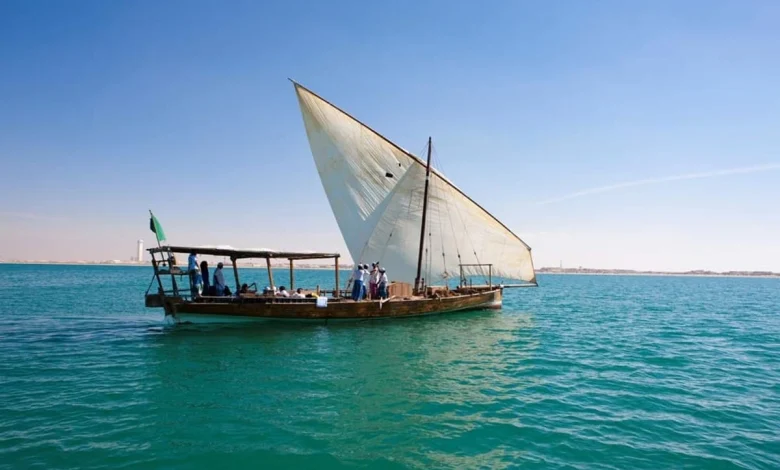
Chants of the Sea: Discovering the Captivating Soundscapes of Fijiri Music in the Arabian Gulf
Fijiri music, the traditional sea chants of the Arabian Gulf, echoed through an era that revolved around a single precious gem. The pearl industry dominated life before oil’s discovery, employing nearly 60,000 people across the Gulf region from Kuwait to Oman—almost the entire population. The deep connection to pearling resonated in the words of Mohammed bin Thani, the first leader of the Qatari people, who declared, “We are all from the highest to the lowest slaves of one master, Pearl”.
The maritime era’s pearl diving transcended mere occupation and became a dangerous way of life. Divers faced deadly challenges on hunting expeditions lasting up to five months. Malnutrition, disease, shark attacks, and drowning posed constant threats. Notwithstanding that, these hardships gave birth to Fijiri—the distinctive vocal music tradition of Eastern Arabia’s coastal Gulf states, particularly Bahrain and Kuwait. A lead singer’s voice soared above a chorus of accompanying singers and rhythmic clapping in this unique musical form. British ethnomusicologist David Fanshawe arrived in the late 1960s to document these sea chants, but found only four ships still participated in pearl fishing.
The Origins of Fijiri and Gulf Pearl Diving
Image Source: Dubai Sotheby’s International Realty
Maritime trade and pearl diving were the economic foundations of the Arabian Gulf before oil turned it into a global economic powerhouse. The sea shaped these coastal societies’ identity and livelihood from the 18th century until the early 20th century.
Life before oil: the maritime economy of the Gulf
A network of port settlements connected the Persian Gulf to transcontinental trade routes. These “brides of the sea” created links between the Mediterranean, Red Sea, and South East Asia. Port towns like Manama, Kuwait, and Dubai became vital trade hubs where powerful tribal rulers controlled maritime outposts.
The region was one of the poorest areas worldwide before oil discovery. Pearl diving sustained the economy, along with subsistence agriculture in coastal areas, international trade in port cities, and traditional nomadic practices inland. Merchants from nearby Gulf areas and India dominated trade, working with local Gulf merchants and bringing seasonal workers for fishing and pearling industries.
Traditional pearl diving and its dangers
The pearl hunting season, known locally as “Ghous al-Kabir,” ran from May to September. Expert divers called “ghawas” would swim down to 40 feet underwater without any breathing equipment. These skilled men relied on their lung capacity and generational diving techniques. They could hold their breath up to two minutes while gathering oysters.
The divers faced constant dangers including malnutrition, anemia, scurvy, trachoma, and attacks by swordfish and sharks, with drowning being an ever-present threat. Their protective gear was basic – a bone or wood nose plug, leather finger-guards, an ankle-attached stone weight, and sometimes a cotton bodysuit for jellyfish protection. The divers worked at depths between seven to 30 meters, collecting up to 20 oysters per dive and making about 40 dives each day.
Cultural roots of Fijiri in seafaring communities
Muharraq Island in Bahrain saw the birth of Fijiri music in the late 19th century. Pearl divers created this unique musical tradition to find emotional solace from their dangerous work. Each vessel’s captain employed a specialist singer known as “nahhām” who performed songs to boost crew morale.
Fijiri’s origins are steeped in supernatural tales. One story tells of three Dilmun wanderers meeting mysterious jinns – demons appearing as half-human, half-donkey creatures – who taught them these songs. Weekly gatherings in buildings called “dar,” often at the captain’s home, brought together up to forty men. They drank coffee and tea, smoked, shared stories of sailing hardships, and danced until dawn. Fijiri evolved beyond mere entertainment into a crucial cultural expression that helped seafaring communities cope with their challenging lives.
Fijiri in Daily Life on the Sea
Image Source: EastEast.World
Pearl diving vessels came alive with music that energized exhausted crews and gave them emotional release. A specialized performer stood as the cornerstone of this maritime musical tradition, and their significance ran deep.
The role of the nahham (lead singer)
Every pearl diving expedition relied on a nahham—a professional vocalist hired purely for his singing talents. The nahham’s job differed from other crew members because he focused only on keeping crew spirits high through song. These talented singers delivered poetic verses in remarkably high pitches that carried far across the water. The crew would answer the nahham’s complex vocal lines with loud shouts. These responses created drone-like patterns several octaves lower and produced an effect that seemed to match the sounds divers heard on the seafloor.
Songs for rowing, anchoring, and departure
Each activity during a pearling expedition had its own musical accompaniment:
- Meydaf songs helped crews row in unison
- Basseh set the mood for extended voyages
- Qaylami played before quick trips
- Khrab gave rhythm as sailors pulled up anchors
The crew also sang special “holo” songs that praised Allah and Muhammad once the captain ordered the sails ready.
Dar gatherings and their social function
Fijiri music lived on in communal spaces known as “dar”—usually the captain’s house or local meeting spots. These gatherings let sailors perform fijiri while docked and share their experiences. The music grew richer with percussion instruments: double-headed drums (tabl bahri and mirwas), frame drums (tar), metal cups used like cymbals (tuus), and water jugs (jahala) that served as idiophones. The performers added unique slow movements and sudden jumps that mimicked diving actions, bringing maritime life’s full artistic expression to shore.
Musical Structure and Instruments of Fijiri
Image Source: Smithsonian Folklife Festival – Smithsonian Institution
Fijiri’s musical architecture creates a distinctive sonic landscape that mirrors pearl diving life’s rhythms. Each performance combines precise vocal techniques and percussion into an array of sound unique to the Arabian Gulf.
Call and response format
A call-and-response structure defines Fijiri where the nahham (lead singer) initiates musical phrases answered by the chorus. Maritime trade over centuries brought these conversational patterns from traditional African musical techniques to the Gulf. The nahham delivers complex vocal lines while the crew responds with phrases. This democratic participation remains fundamental to the tradition.
Use of drums: tabl, mirwas, tar
Several key instruments provide Fijiri performances’ percussion backbone:
- The mirwās – a small double-sided hand drum produces high-pitched sounds
- The tar – a frame drum resembles a large tambourine without jingles
- The jāhlah (clay pot) – both hands create distinctive rhythms
Clapping and body movement
Performers use various techniques like flat hand claps and star claps as integral percussion elements. Their body movements combine slow motions with sudden jumps that symbolize diving actions. These physical representations capture pearl diving’s dangers and rhythms.
Drone effects and vocal layering
Performers create hypnotic drone effects through sustained tones and overlapping vocals. This establishes a fundamental frequency for melodic elements. The layering technique generates a mystical sound quality. Continuous overtone changes throughout performances create a sonic environment that resembles underwater experiences.
From Work Songs to Cultural Heritage
Pearl diving started declining in the 1930s after Japan developed cultured pearl technology and oil was found in the Gulf. The socioeconomic fabric of coastal communities changed, and pearl diving along with its musical traditions almost disappeared.
Decline of pearl diving and its effect
Pearl fishing dwindled to just four ships by the late 1960s. Pearl hunting lost its commercial value, which made it impossible for workers to sing their traditional songs during work. Fijiri moved from being functional work music to become a celebrated piece of cultural heritage.
Preservation efforts and UNESCO recognition
UNESCO added Bahraini fijiri to its Representative List of the Intangible Cultural Heritage of Humanity in December 2021. This recognition highlighted fijiri as “a musical performance that commemorates the history of pearl diving” and showed “the connection between the Bahraini people and the sea”.
Modern performances and reinterpretations
Today, people can enjoy fijiri performances in shopping malls, concert halls, and cultural festivals. Artists blend classical elements with symphonic music, and some electronic musicians give these traditional sounds a modern twist.
Fijiri in education and public events
Musicians now perform at weddings and community celebrations. Many practitioners teach these musical traditions to children to help them connect with their maritime heritage. This cultural grounding helps preserve their rich history.
Fijiri music stands as evidence of the Arabian Gulf coastal communities’ resilience and creativity. These haunting melodies supported pearl divers psychologically through centuries of dangerous expeditions at sea. The sailors faced life-threatening conditions every day. Their musical tradition perfectly suited maritime life with its complex call-and-response patterns, distinctive percussion, and group performances.
The pearl diving industry collapsed in the early 20th century. Fijiri survived all the same. These musical traditions became deeply rooted in Gulf identity and shifted from work songs to celebrated cultural heritage. UNESCO’s recognition in 2021 is without doubt proof of what local communities always knew – Fijiri means more than simple work songs. It captures the spiritual bond between Gulf peoples and their maritime past.
Today’s performances happen in shopping malls, festivals, and concert venues far from wooden dhows and diving dangers. These new presentations play a significant role that connects younger generations to their seafaring heritage. The tradition evolves instead of vanishing. Professional musicians keep Fijiri alive at weddings and community celebrations rather than letting it become a museum piece.
Fijiri’s story shows how art emerges from necessity. Simple rhythmic coordination for physical work ended up becoming complex musical expression that outlived its original purpose. The region’s economy changed dramatically and pearl diving became obsolete. Yet the sea’s songs continue to strike a chord throughout the Arabian Gulf. Fijiri lives on as historical record and evolving art – a powerful sonic bridge between past and present.




